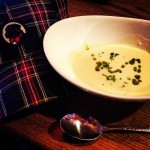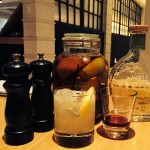Going to Savannah during the off-season felt like walking on the beach during low tide; something was missing. All the lawns were still perfectly kept, the architectural gems were on display, and the restaurants served up warm dishes daily but without the numerous tourists who flock during the summer. The city felt smaller, private, and strangely more serious.
My first move was to take a trolley ride to escape the impending rainstorm and admire the Regency, Victorian, and colonial era houses that surround each square. Their elaborate ironwork and anthropomorphic rain gutters add to the mystique of a city defined by the antebellum south. Savannah was a town lucky enough to physically escape the ravaging of Sherman’s march to the sea but there still remains a psychological scar from the war between the states.
Eventually the chill got the best of me and I hopped off at Washington Square and stepped into the newly opening Brice Hotel and Pacci Restaurant. An Alice in Wonderland feeling hit me immediately as I was taken aback by the modern black and white color scheme with whimsical design elements. As I walked around the South’s answer to the 21c Hotel, I was enchanted with the detail of curved book shelves filled with dual tone books organized in an obsessively perfect fashion, which created an inviting interactive installation piece.
After oogling the art I headed to the restaurant where the bartender was kind enough to whip up a handmade cocktail that can best be described as a liquid dinner party. There were a lot of characters (Bourbon, Tequila, Pears, etc.) and when they get together they have a great conversation. The entire environment from floor to ceiling was strategically designed and created a clean, modern, atmosphere in a city well known for its storied past.
The second day was slightly less soggy and after dodging puddles on the cobblestone streets I headed over to Rocks On The River at the Bohemian Hotel located in the Cotton Exchange district, which is known for its haunted hallways and dank taverns, The Rock managed to the keep those elements alive but also brought new zeal into the interior by using snappy contemporary art by a Basquiat influenced artist and driftwood sculptures that tied the place together with a humble yet elegant bow. While sitting on the open air patio gazing out onto the harbor where mammoth barges passed by I indulged in She-Crab Soup with a cilantro drizzle and was pleasantly surprised to find the creamy, buttery, and yet sweet texture the perfect pick me up for a chilly, southern afternoon.
The only earthly pleasure I had left to indulge in while in Savannah was the Jepson Center. The Jepson Center was founded in 2006 and houses contemporary art exhibitions, a community art gallery, and extensive educational programming. It is also a sister to the more traditional Telfair Museum, which sits in the same square.
Among the light filled hallways was a gallery tucked in the back where the site-specific work “Deep River” by Whitfield Lovell was on display. The emotionally charged conversation piece sat in perfect juxtaposition to the simple mindset that allows visitors to overlook the history of slavery while they sip sweet tea on historical tours, dreaming of the glory that was the Camelot of the civil war.
Before entering Lovell’s work the mood was induced by walking through traditional tableaux works from his ‘Kin’ series which creates an unspoken narrative by pairing objects with portraits of anonymous African Americans throughout history. One of these portraits featured a stack of old Crosley radios, one of which let out the soft voice of Billie Holiday, which sat heavy in the air like the fog sits over the harbor. Holiday sang a lot of Johnny Mercer songs, who was from Savannah.
Finally reaching the doors that lead into “Deep River” I was struck by the stillness of the room. Looking out into the center you can see the outline of objects carefully placed on top of the pile of dirt, and above walls that play a looped video of lapping river water. However it was the experience of standing in the center and seeing the numerous wooden circles of every shape and size with haunting eyes staring through you that force introspection and consideration for the innocent lives lost during the civil war.
After leaving the hypnotizing circle, a final work was exhibited, in a room filled with baggage scattered across the floor. In the corner, a pile over 5 feet high with a set of wooden doors and the image of a strikingly dapper man was standing in between. He held a cane and wore a proper hat, but just to the left of his regal image was an open suitcase filled with chains, and it was then that Lovell’s message hit home. This proud man may be free but the emotional baggage of his servitude would last eternally, always packed in the suitcase in his head.
Stepping out of the exhibit, down the pristine alabaster colored stairs and out into the lush tree lined square, I finally realized what was missing. Savannah as we know it was made to be a fantasyland of antiquities, but it is the recognition of what is happening beneath the surface that has gone unnoticed, the growing arts and culinary scene is quickly rising to high tide and should be taken in and taken seriously. Both Charleston and Savannah have recycled their histories into effective tourist attractions. But in Savannah’s case, the book Midnight in the Garden of Good and Evil, later made into a film in the 1990’s, overlays another Savannah on top of the historical one. The book is as responsible for the tourism boom as the Chamber of Commerce is. Savannah is also the home of the highly esteemed Savannah College of Art and Design.
–Katie Dreyer









